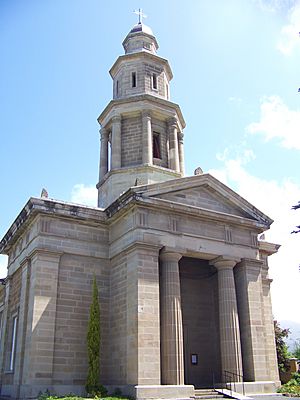St George's Anglican Church, Battery Point facts for kids
Quick facts for kids St George's Anglican Church, Battery Point |
|
|---|---|
 |
|
| 42°53′29″S 147°19′55″E / 42.89151°S 147.33208°E | |
| Location | Cromwell Street, Battery Point, Hobart, Tasmania |
| Country | Australia |
| Denomination | Anglican |
| History | |
| Status | Church |
| Architecture | |
| Functional status | Active |
| Architect(s) |
|
| Specifications | |
| Materials | Sandstone |
St George's Anglican Church is a beautiful old church located in Battery Point, Hobart, Tasmania, Australia. It's a special place for people who follow the Anglican faith. This historic building was first designed way back in 1838 and is made from strong sandstone.
Contents
A Look at St George's Church
What is an Anglican Church?
St George's is an Anglican church, which means it belongs to a Christian group called the Anglican Church of Australia. This church is a "parish church," which is like a local church for a specific area or community. It's a place where people gather for worship, community events, and to celebrate important moments in their lives.
Who Designed This Historic Building?
The main part of St George's Church was designed by an architect named John Lee Archer in 1838. He was a very important architect in Tasmania at that time. Later, another architect, James Blackburn, added some famous parts to the church. He designed the tall bell tower and the grand entrance, called a portico.
The Tower: A Guiding Light
The bell tower of St George's Church is more than just a place for bells. For many years, it served as a very important landmark. Sailors and boat captains used it to help them navigate the Derwent River. It was like a tall, stone signpost guiding them safely along the river's mouth and into the harbor.

